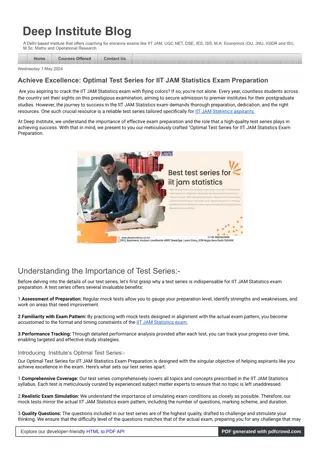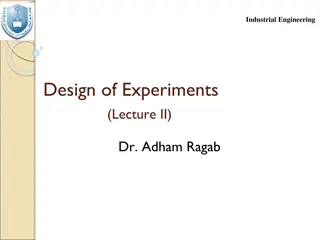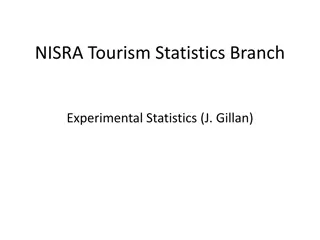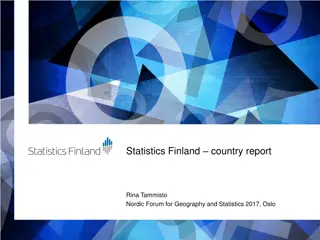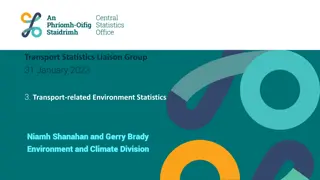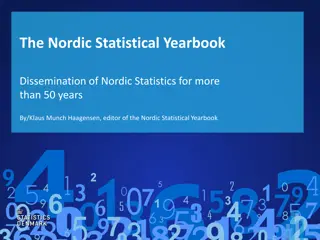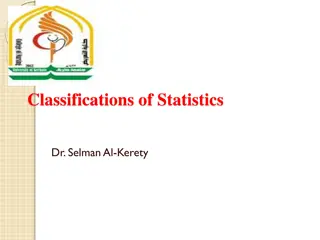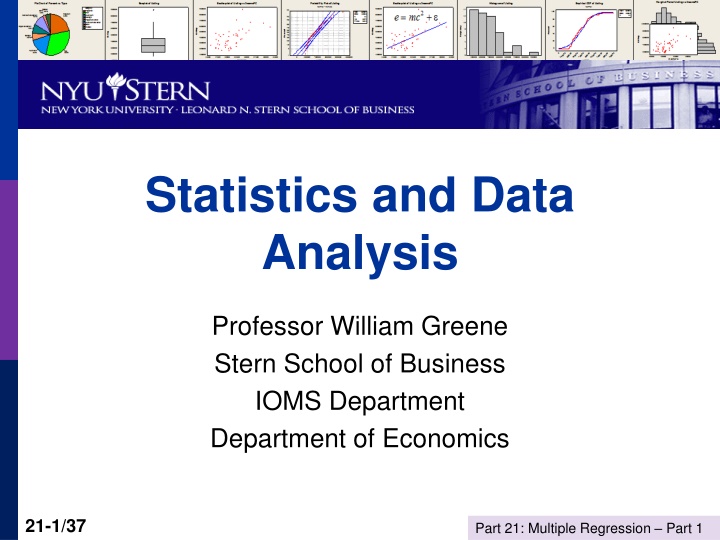
Multiple Regression Analysis Applications
Explore the applications of multiple regression analysis in assessing health satisfaction differences between men and women, computing regression equations, building regression models, and more. Discover how other factors influence the assessment process and the concept of conditional means in statistical analysis.
Download Presentation

Please find below an Image/Link to download the presentation.
The content on the website is provided AS IS for your information and personal use only. It may not be sold, licensed, or shared on other websites without obtaining consent from the author. If you encounter any issues during the download, it is possible that the publisher has removed the file from their server.
You are allowed to download the files provided on this website for personal or commercial use, subject to the condition that they are used lawfully. All files are the property of their respective owners.
The content on the website is provided AS IS for your information and personal use only. It may not be sold, licensed, or shared on other websites without obtaining consent from the author.
E N D
Presentation Transcript
Statistics and Data Analysis Professor William Greene Stern School of Business IOMS Department Department of Economics 21-1/37 Part 21: Multiple Regression Part 1
Statistics and Data Analysis Part 21 Multiple Regression: 1 21-2/37 Part 21: Multiple Regression Part 1
21-3/37 Part 21: Multiple Regression Part 1
21-4/37 Part 21: Multiple Regression Part 1
21-5/37 Part 21: Multiple Regression Part 1
21-6/37 Part 21: Multiple Regression Part 1
21-7/37 Part 21: Multiple Regression Part 1
21-8/37 Part 21: Multiple Regression Part 1
Women appear to assess health satisfaction differently from men. 21-9/37 Part 21: Multiple Regression Part 1
Or do they? Not when other things are held constant 21-10/37 Part 21: Multiple Regression Part 1
21-11/37 Part 21: Multiple Regression Part 1
21-12/37 Part 21: Multiple Regression Part 1
Multiple Regression Agenda The concept of multiple regression Computing the regression equation Multiple regression model Using the multiple regression model Building the multiple regression model Regression diagnostics and inference 21-13/37 Part 21: Multiple Regression Part 1
Concept of Multiple Regression Different conditional means Application: Monet s signature Holding things constant Application: Price and income effects Application: Age and education Sales promotion: Price and competitors The general idea of multiple regression 21-14/37 Part 21: Multiple Regression Part 1
Monet in Large and Small Logs of Sale prices of 328 signed Monet paintings Fitted Line Plot ln (US$) = 2.825 + 1.725 ln (SurfaceArea) 18 S R-Sq R-Sq(adj) 1.00645 20.0% 19.8% 17 16 15 The residuals do not show any obvious patterns that seem inconsistent with the assumptions of the model. ln (US$) 14 13 12 11 6.0 6.2 6.4 6.6 6.8 7.0 7.2 7.4 7.6 ln (SurfaceArea) Log of $price = a + b log surface area + e 21-15/37 Part 21: Multiple Regression Part 1
How much for the signature? The sample also contains 102 unsigned paintings Average Sale Price Signed $3,364,248 Not signed $1,832,712 Average price of a signed Monet is almost twice that of an unsigned one. 21-16/37 Part 21: Multiple Regression Part 1
Can we separate the two effects? Average Prices Small Large Unsigned 346,845 5,795,000 Signed 689,422 5,556,490 What do the data suggest? (1) The size effect is huge (2) The signature effect is confined to the small paintings. 21-17/37 Part 21: Multiple Regression Part 1
Thought experiments: Ceteris paribus Monets of the same size, some signed and some not, and compare prices. This is the signature effect. Consider signed Monets and compare large ones to small ones. Likewise for unsigned Monets. This is the size effect. 21-18/37 Part 21: Multiple Regression Part 1
A Multiple Regression Scatterplot of ln (US$) vs ln (SurfaceArea) 18 Signed 0 1 17 16 b2 15 ln (US$) 14 13 12 11 10 6.0 6.2 6.4 6.6 6.8 7.0 7.2 7.4 7.6 ln (SurfaceArea) Ln Price = a + b1 ln Area + b2 (0 if unsigned, 1 if signed) + e 21-19/37 Part 21: Multiple Regression Part 1
21-20/37 Part 21: Multiple Regression Part 1
Monet Multiple Regression Regression Analysis: ln (US$) versus ln (SurfaceArea), Signed The regression equation is ln (US$) = 4.12 + 1.35 ln (SurfaceArea) + 1.26 Signed Predictor Coef SE Coef T P Constant 4.1222 0.5585 7.38 0.000 ln (SurfaceArea) 1.3458 0.08151 16.51 0.000 Signed 1.2618 0.1249 10.11 0.000 S = 0.992509 R-Sq = 46.2% R-Sq(adj) = 46.0% Interpretation (to be explored as we develop the topic): (1) Elasticity of price with respect to surface area is 1.3458 very large (2) The signature multiplies the price by exp(1.2618) (about 3.5), for any given size. 21-21/37 Part 21: Multiple Regression Part 1
Ceteris Paribus in Theory Demand for gasoline: G = f(price,income) Demand (price) elasticity: eP = %change in G given %change in P holding income constant. How do you do that in the real world? The percentage changes How to change price and hold income constant? 21-22/37 Part 21: Multiple Regression Part 1
The Real World Data 21-23/37 Part 21: Multiple Regression Part 1
U.S. Gasoline Market, 1953-2004 Time Series Plot of logG, logIncome, logPg 5 Variable logG logIncome logPg 4 Data 3 2 1 1953 1961 1969 1977 1985 1993 2001 Year 21-24/37 Part 21: Multiple Regression Part 1
Shouldnt Demand Curves Slope Downward? Scatterplot of GasPrice vs G 140 120 100 80 GasPrice 60 40 20 0 0.30 0.35 0.40 0.45 0.50 0.55 0.60 0.65 G 21-25/37 Part 21: Multiple Regression Part 1
A Thought Experiment The main driver of gasoline consumption is income not price Income is growing over time. We are not holding income constant when we change price! How do we do that? Scatterplot of g vs Income 7 6 5 g 4 3 10000 12500 15000 17500 20000 22500 25000 27500 Income 21-26/37 Part 21: Multiple Regression Part 1
How to Hold Income Constant? Multiple Regression Using Price and Income Regression Analysis: G versus GasPrice, Income The regression equation is G = 0.134 - 0.00163 GasPrice + 0.000026 Income Predictor Coef SE Coef T P Constant 0.13449 0.02081 6.46 0.000 GasPrice -0.0016281 0.0004152 -3.92 0.000 Income 0.00002634 0.00000231 11.43 0.000 It looks like the theory works. 21-27/37 Part 21: Multiple Regression Part 1
A Conspiracy Theory for Art Sales at Auction Sotheby s and Christies, 1995 to about 2000 conspired on commission rates. 21-28/37 Part 21: Multiple Regression Part 1
If the Theory is Correct Scatterplot of ln (US$) vs ln (SurfaceArea) 18 Sold from 1995 to 2000 17 16 Sold before 1995 or after 2000 15 14 ln (US$) 13 12 11 10 9 3 4 5 6 7 8 9 ln (SurfaceArea) 21-29/37 Part 21: Multiple Regression Part 1
Evidence The statistical evidence seems to be consistent with the theory. 21-30/37 Part 21: Multiple Regression Part 1
A Production Function Multiple Regression Model Sales of (Cameras/Videos/Warranties) = f(Floor Space, Staff) 21-31/37 Part 21: Multiple Regression Part 1
Production Function for Videos How should I interpret the negative coefficient on logFloor? 21-32/37 Part 21: Multiple Regression Part 1
An Application to Credit Modeling 21-33/37 Part 21: Multiple Regression Part 1
Age and Education Effects on Income 21-34/37 Part 21: Multiple Regression Part 1
A Multiple Regression +----------------------------------------------------+ | LHS=HHNINC Mean = .3520836 | | Standard deviation = .1769083 | | Model size Parameters = 3 | | Degrees of freedom = 27323 | | Residuals Sum of squares = 794.9667 | | Standard error of e = .1705730 | | Fit R-squared = .07040754 | +----------------------------------------------------+ +--------+--------------+-----------+ |Variable| Coefficient | Mean of X| +--------+--------------+-----------+ Constant| -.39266196 AGE | .02458140 43.5256898 EDUC | .01994416 11.3206310 +--------+--------------+-----------+ 21-35/37 Part 21: Multiple Regression Part 1
Education and Income Effects 21-36/37 Part 21: Multiple Regression Part 1
Summary Holding other things constant when examining a relationship The multiple regression concept Multiple regression model Applications: Size and signature Model building for credit applications Quadratic relationship between income and education 21-37/37 Part 21: Multiple Regression Part 1


